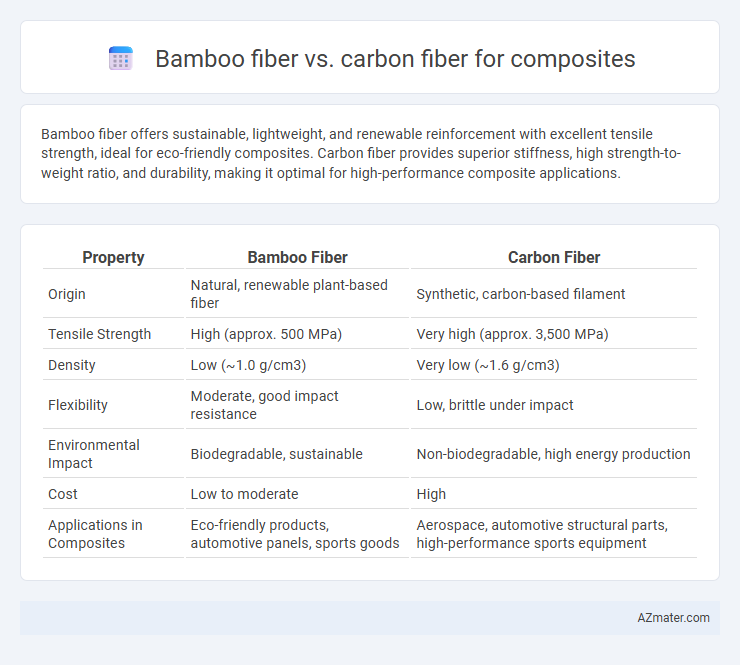Bamboo fiber offers sustainable, lightweight, and renewable reinforcement with excellent tensile strength, ideal for eco-friendly composites. Carbon fiber provides superior stiffness, high strength-to-weight ratio, and durability, making it optimal for high-performance composite applications.
Table of Comparison
| Property | Bamboo Fiber | Carbon Fiber |
|---|---|---|
| Origin | Natural, renewable plant-based fiber | Synthetic, carbon-based filament |
| Tensile Strength | High (approx. 500 MPa) | Very high (approx. 3,500 MPa) |
| Density | Low (~1.0 g/cm3) | Very low (~1.6 g/cm3) |
| Flexibility | Moderate, good impact resistance | Low, brittle under impact |
| Environmental Impact | Biodegradable, sustainable | Non-biodegradable, high energy production |
| Cost | Low to moderate | High |
| Applications in Composites | Eco-friendly products, automotive panels, sports goods | Aerospace, automotive structural parts, high-performance sports equipment |
Introduction: Comparing Bamboo Fiber and Carbon Fiber
Bamboo fiber and carbon fiber represent two distinct materials used in composite manufacturing, each offering unique properties. Bamboo fiber is a natural, sustainable resource known for its lightweight, flexibility, and biodegradability, making it ideal for eco-friendly applications. Carbon fiber, composed of carbon atoms bonded in a crystal structure, provides exceptional strength, stiffness, and high tensile strength, widely utilized in aerospace, automotive, and sports industries for high-performance composites.
Material Composition and Source
Bamboo fiber is a natural composite material primarily composed of cellulose, hemicellulose, and lignin derived from fast-growing bamboo plants, offering a renewable and biodegradable source. Carbon fiber consists of thin strands of carbon atoms arranged in a crystalline structure, produced from polyacrylonitrile (PAN) or pitch precursors through high-temperature carbonization, resulting in enhanced strength and stiffness. The bamboo fiber's organic origin contrasts with the synthetic, energy-intensive production of carbon fiber, influencing sustainability and mechanical property considerations in composite applications.
Mechanical Strength and Durability
Bamboo fiber composites exhibit high tensile strength and excellent impact resistance due to their natural cellulose structure, making them suitable for lightweight, sustainable applications. Carbon fiber composites outperform bamboo in mechanical strength with superior stiffness, tensile modulus up to 230 GPa, and durability under cyclic loading, ideal for aerospace and automotive industries. While bamboo fiber offers biodegradability and cost-effectiveness, carbon fiber provides unmatched fatigue resistance and long-term performance in harsh environmental conditions.
Weight and Density Differences
Bamboo fiber composite offers a significant weight advantage due to its low density, approximately 0.6-0.9 g/cm3, compared to carbon fiber's higher density of around 1.6 g/cm3. This lower density in bamboo fiber composites results in lighter materials ideal for applications where weight reduction is critical. Carbon fiber composites, despite being heavier, provide superior strength-to-weight ratios and stiffness, making them suitable for high-performance engineering applications.
Environmental Impact and Sustainability
Bamboo fiber, derived from a fast-growing renewable resource, offers significant environmental benefits including carbon sequestration, biodegradability, and low energy consumption during production, making it a sustainable alternative to synthetic fibers. Carbon fiber composites, while providing superior strength-to-weight ratios and durability, involve energy-intensive manufacturing processes with substantial carbon emissions and recyclability challenges. Choosing bamboo fiber composites can reduce ecological footprints in automotive and construction industries by leveraging renewable materials and decreasing reliance on fossil fuel-based fibers.
Cost Efficiency and Availability
Bamboo fiber offers a cost-efficient and sustainable alternative to carbon fiber, with significantly lower raw material and processing expenses, making it ideal for budget-conscious composite applications. Widely available in tropical and subtropical regions, bamboo fiber benefits from rapid renewability and minimal environmental impact, while carbon fiber remains costly due to energy-intensive production and limited sources. For large-scale, eco-friendly manufacturing, bamboo fiber composites provide an accessible and affordable solution compared to the premium-priced, high-performance carbon fiber counterparts.
Processing and Manufacturing Techniques
Bamboo fiber composites utilize traditional extraction methods like retting and mechanical processing, followed by resin infusion or compression molding, offering eco-friendly and cost-effective manufacturing. Carbon fiber composites require advanced processes including precursor oxidation, carbonization at high temperatures, and expensive autoclave curing or resin transfer molding for high strength-to-weight ratios. Bamboo fiber processing favors lower energy consumption and simpler equipment, while carbon fiber demands precise temperature control and specialized facilities for optimal material properties.
Applications in Composite Materials
Bamboo fiber offers a sustainable and biodegradable alternative to traditional carbon fiber in composite materials, making it ideal for eco-friendly automotive panels and lightweight construction components. Carbon fiber composites excel in high-performance applications such as aerospace, sports equipment, and automotive parts due to their superior strength-to-weight ratio and rigidity. The choice between bamboo and carbon fiber composites depends on the balance of environmental impact, mechanical properties, and cost requirements specific to each application.
Performance in Real-World Uses
Bamboo fiber composites exhibit excellent tensile strength and flexibility, making them ideal for lightweight, sustainable applications such as automotive interiors and sports equipment. Carbon fiber composites outperform bamboo in stiffness and high-temperature resistance, offering superior strength-to-weight ratios essential for aerospace, racing, and high-performance engineering. Real-world usage shows bamboo fibers excel in vibration damping and eco-friendly design, while carbon fibers dominate where maximum rigidity and durability are critical.
Future Trends and Innovations
Bamboo fiber composites are gaining traction for sustainable applications due to their biodegradability and low environmental impact, attracting innovation in natural fiber treatments and hybrid composites to enhance mechanical properties. Carbon fiber composites continue to dominate high-performance sectors with ongoing advancements in manufacturing techniques such as automated fiber placement and nanomaterial integration, improving strength-to-weight ratios and cost-efficiency. Future trends emphasize combining bamboo's eco-friendly attributes with carbon fiber's strength to develop hybrid composites that optimize sustainability and performance across automotive, aerospace, and construction industries.

Infographic: Bamboo fiber vs Carbon fiber for Composite
 azmater.com
azmater.com